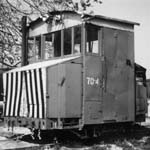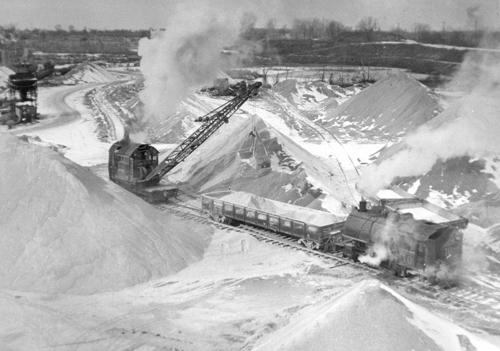Locomotives

Click for Slide Show
Scenes

Click for Slide Show
The Old Days

Click for Photograph

Click to enlarge.
This is a storage yard for ground limestone ready for sale.
It is cold with snow on the ground and lots of escaping steam swirlling around saddle tank locomotive No. 10.
The steam shovel is unloading a gondola car.
As early as the 1840s limestone was being dug out of the area on the northwest side of Columbus which was to become the American Aggregates and Marble Cliff Quarries.
There is a belt of limestone called Columbus limestone that runs from Ohio’s state capital north to Lake Erie. From a multitude of limestone quarries came the stone blocks, stone of various sizes down to gravel and limestone powder used in construction, farming and chemical processes. For example one of the major uses for limestone quarried at Marble Cliff Quarry in the 1950s was for use as flux to purify iron ore. It helped remove the mud and other impurities from the iron ore as part of the steel making process. Steel mills in Pittsburgh and Weirton, WV were customers of the Marble Cliff Quarry.
In the beginning the quarry work was done with horse drawn wagons, black powder and the brute strength of a small army of men. When mechanization entered the picture is unclear and would have been introduced gradually over time. The first mention of a railroad I found was in an 1880 newspaper article. A 1902 newspaper account of a fire that destroyed one of the quarry’s crushers mentioned small locomotives used in the plant. The Marble Cliff Quarry locomotives shown here date from the 1920s. They were at least the second if not third generation locomotives used at the quarry. They were also the last since in 1957 the quarry converted to trucks and diesel locomotives. In late 1971 the MCQ railroad was abandoned.
The locomotives were referred to as dockside or saddle tank engines. They did not have tenders but rather water tanks that sat atop the boilers like a saddle on a horse. Coal was kept in a bunker behind the cab. Since the locomotives were never far from coal and water supplies it did not matter that they had such a limited capacity. The term dockside used by some comes from the use of this type of locomotive around ship docks on the east coast.
Steam powered shovels were also used at Marble Cliff Quarry as shown in the photo above. Marble Cliff Quarry employees maintained both the locomotives and shovels which require skilled boiler makers and other railroad shop men.
They also had multiple rock crushers to process the raw material which can be seen in some of the photos. The rock crushers were large, noisy and very dusty machines that took the large quarried rocks and turned them into uniform sized stone, gravel and powder. The saddle tank locomotives carried the raw material to the crushers and if the finished material was to be stored, rather than immediately loaded into railroad hopper cars for shipment, taken to the storage yard.
In 2012 limestone is still being quarried north of Trabue Road. The remainder of the property is being redeveloped into upscale homes and apartments surrounding the lakes formed at the old quarry sites. The area is quite attractive with heavily forested growth that has become an attraction for migrating birds. Only two abandoned bridges and slight traces of road bed remain from the Marble Cliff Quarry railroad days.
A special thanks to Galen Gonser, David Bunge, James Osborn and Richard Nadalin for help in preparing this article. Grandview Heights/Marble Cliff Historical Society publications were also appreciated.
There is a belt of limestone called Columbus limestone that runs from Ohio’s state capital north to Lake Erie. From a multitude of limestone quarries came the stone blocks, stone of various sizes down to gravel and limestone powder used in construction, farming and chemical processes. For example one of the major uses for limestone quarried at Marble Cliff Quarry in the 1950s was for use as flux to purify iron ore. It helped remove the mud and other impurities from the iron ore as part of the steel making process. Steel mills in Pittsburgh and Weirton, WV were customers of the Marble Cliff Quarry.
In the beginning the quarry work was done with horse drawn wagons, black powder and the brute strength of a small army of men. When mechanization entered the picture is unclear and would have been introduced gradually over time. The first mention of a railroad I found was in an 1880 newspaper article. A 1902 newspaper account of a fire that destroyed one of the quarry’s crushers mentioned small locomotives used in the plant. The Marble Cliff Quarry locomotives shown here date from the 1920s. They were at least the second if not third generation locomotives used at the quarry. They were also the last since in 1957 the quarry converted to trucks and diesel locomotives. In late 1971 the MCQ railroad was abandoned.
The locomotives were referred to as dockside or saddle tank engines. They did not have tenders but rather water tanks that sat atop the boilers like a saddle on a horse. Coal was kept in a bunker behind the cab. Since the locomotives were never far from coal and water supplies it did not matter that they had such a limited capacity. The term dockside used by some comes from the use of this type of locomotive around ship docks on the east coast.
Steam powered shovels were also used at Marble Cliff Quarry as shown in the photo above. Marble Cliff Quarry employees maintained both the locomotives and shovels which require skilled boiler makers and other railroad shop men.
They also had multiple rock crushers to process the raw material which can be seen in some of the photos. The rock crushers were large, noisy and very dusty machines that took the large quarried rocks and turned them into uniform sized stone, gravel and powder. The saddle tank locomotives carried the raw material to the crushers and if the finished material was to be stored, rather than immediately loaded into railroad hopper cars for shipment, taken to the storage yard.
In 2012 limestone is still being quarried north of Trabue Road. The remainder of the property is being redeveloped into upscale homes and apartments surrounding the lakes formed at the old quarry sites. The area is quite attractive with heavily forested growth that has become an attraction for migrating birds. Only two abandoned bridges and slight traces of road bed remain from the Marble Cliff Quarry railroad days.
A special thanks to Galen Gonser, David Bunge, James Osborn and Richard Nadalin for help in preparing this article. Grandview Heights/Marble Cliff Historical Society publications were also appreciated.